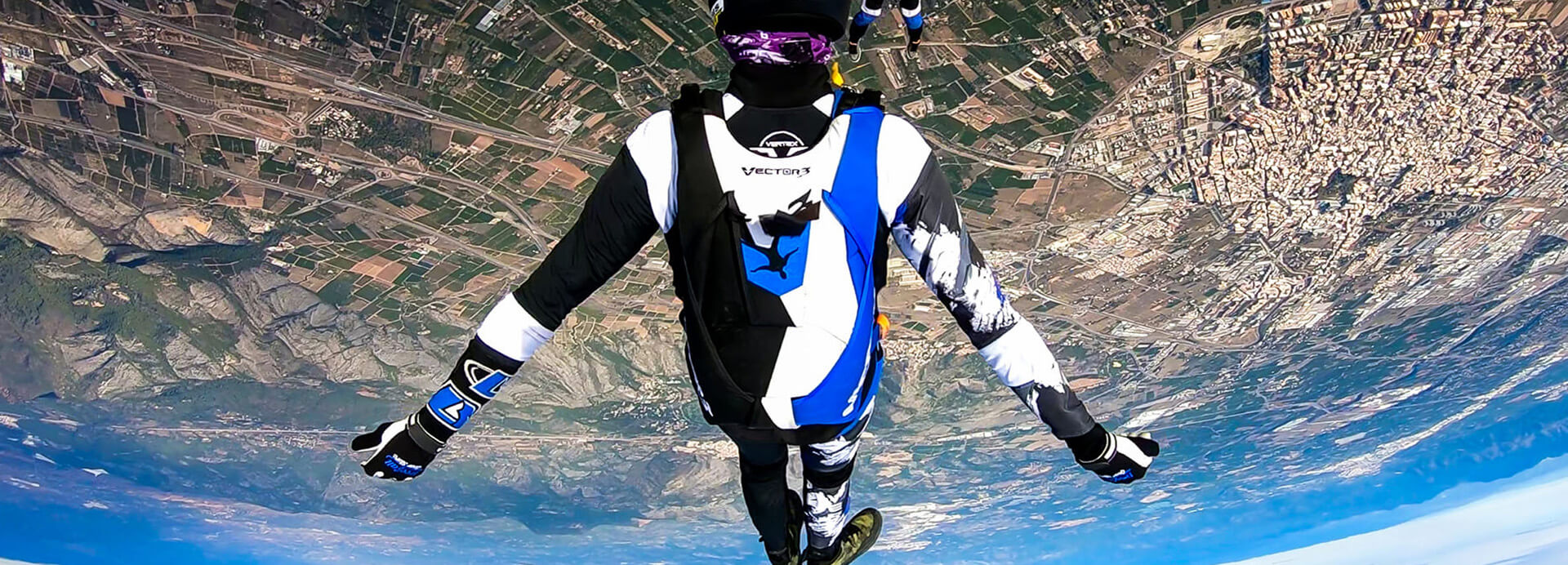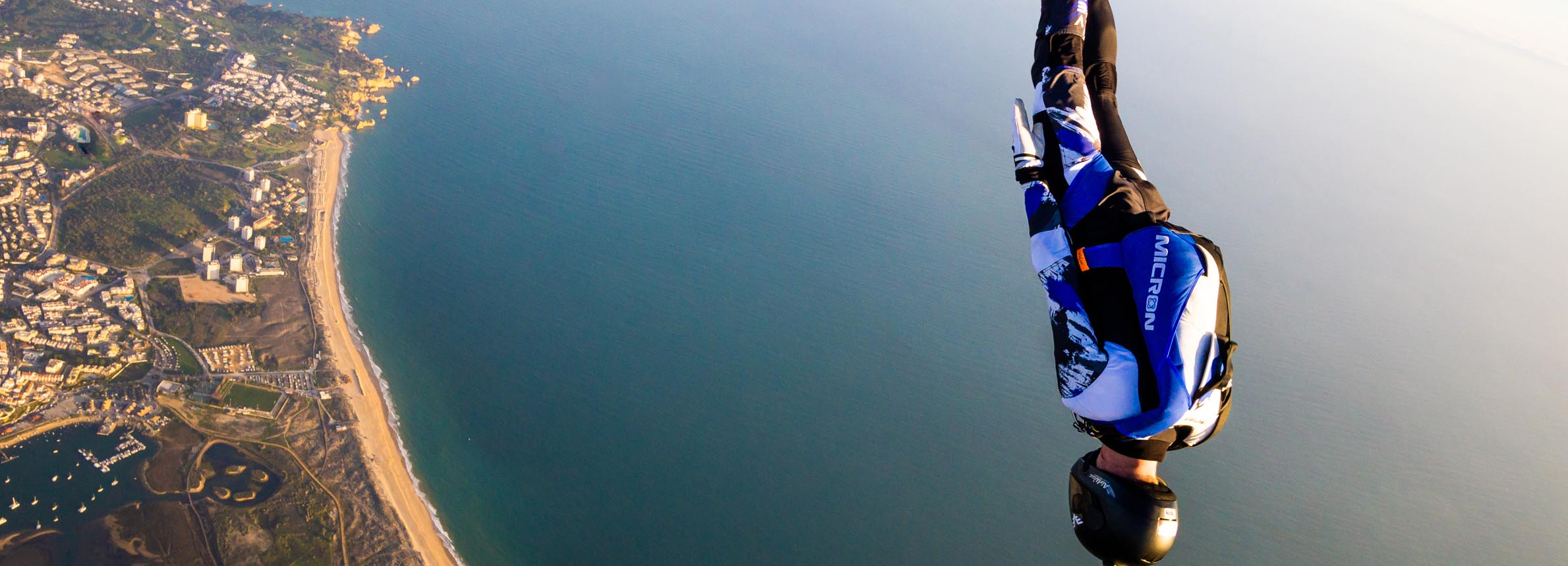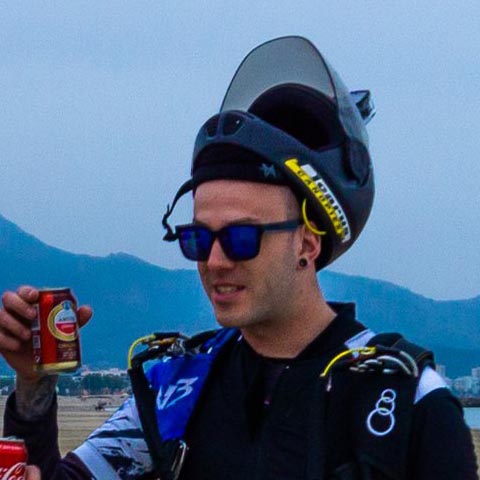Suit Selection
By James Moran
With constant evolution in our sport, we as suit manufacturers need to adapt and evolve our products so that we can keep up with the latest trends and new sub disciplines. A perfect example is the evolution of freeflying and angle flying (tracking) that has seen the complexity and speeds increase significantly over the recent years as well as the fashion that has said goodbye to baggy suits made from porous fabrics to tight fitting nylon suits. I am going to explain a bit about the different specifications to consider when buying your new suit whether you are a total beginner or a ninja in any of the disciplines.
Choosing the right suit for you
Here at Vertex we are really passionate about what we do. We make suits because we love jumping and it only drives us to achieve higher standards in both work and play. We started making suits because we felt that there was a limited range of good quality suits that were affordable at the same time. We work around the clock to improve our suits wherever possible from the minor details to the major ones. The pure foundations of our business are Quality, Service and Price. If we can achieve these 3 things with all of our products then we are achieving our goals! This article is designed to share some of our knowledge with you so that you can make educated choices when designing your new suit.
The first step is to pick the right suit for you! Starting with the basics, if you are very new to the sport (under 100 jumps) then we would advise you to really think about what kind of discipline really makes you excited. In the UK we have a progression system FS1 which is a qualification for belly flying. This is required to be able to jump with your friends in a belly to earth orientation. Most new skydivers will work on and achieve this qualification in their first 100 jumps but continue to progress their belly skills way beyond this.
We often get asked the question. Should i buy a FS suit as my first suit? The answer entirely depends on you! I often have a long discussion with customers when they ask this question and I try to gauge their interests in particular disciplines. Some say to me they really just want to Freefly, or they just want to learn tracking. The reality is that belly flying is a fundamental basic skill that connects to every single skydiving discipline. So, based on this we would recommend for your first suit getting a FS suit if that is what you are going to do. If you tell me that you are definitely not going to do any more belly flying then i would perhaps say that you shouldn't waste your money buying one. However, for the majority of new skydivers you will likely do only belly flying for a considerable period of time or a mix of both belly flying and other disciplines.
Fit Types
At Vertex we try to make the fitting of your suit as simple as possible. There are many manufacturers out there that leave the fitting of the suit up to you to work out! We know that this can be a challenge with little or no knowledge of how suits are tailoured which is why we have created the basic options of Tight, Regular, Relaxed, Loose or Extra Loose fit. There are a couple of other variations on certain products like our camera jacket that doesn't have a tight fit, but for the whole this system works really well and has been developed over thousands of suits.
In general our fit types are as follows; Tight +1cm to measurements provided, Regular +2cm to measurements provided, Relaxed +3cm to measurements provided, Loose +5cm to measurements provided and Extra Loose at +8cm. Without going into too much detail they generally add 1, 2, 3, 5, or 8cm to specific areas of the suit. This has been carefully tailored over time and there are certain areas for example the armpit where we add a little more as it is a common area to experience tightness if the suit isn't fitted properly. This is why you should always follow our guide and not make unnecessary changes to your measurements in the hope that you are potentially fixing a problem that we have already address in our fit type system. It is worth noting that the tight fit is really quite tight (almost skin tight), the regular fit is still quite snug fitting, Relaxed fit is more forgiving than regular, and the loose fit is comfortably loose but certainly not that much so compared to the old school baggy suits. We have added an extra loose for those that know they need a very, very slow suit.
We often get asked questions about how many layers you can fit under each fit type. Well to answer this as simply as possible, we would say that you should always measure in your underwear and a t-shirt or a thin under layer like sports thermals. If you measure as suggested then you should be able to fit a thin layer of thermals under a tight fit, a thin jumper under a regular fit, a slightly thicker jumper or two thin jumpers under a loose fit with a little bit of room to spare.
Fit type would be our number one recommendation to adjust your fall rate in MOST circumstances. This will be covered in a section below with greater detail.
If in doubt, simply get in touch with us by e-mail or facebook. We are always more than happy to help answer any questions you might have.

Fabric Types
Picking the correct fabric for your suit is important to get the right performance from it. Again, to make it simple we have set the fabric selection defaults on each suit designer to what we believe is the most suitable fabric for the majority of people. The normal options are Taslan, Polycotton and Cordura. In brief there are some pros and cons to each fabric type.
Taslan
Pros
- - Strong nylon blend.
- - Lightweight and flexible.
- - Fast.
Cons
- - Offers little in terms of warmth.
- - Might be too fast those that are quite heavy.
Polycotton
Pros
- - Comfortable and flexible.
- - Very slow and good for those who are quite heavy.
- - Warm.
Cons
- - Less durable than Taslan and Cordura.
- - Too slow for those who are quite light.
- - Too warm for hot countries or during summer months.
Cordura
Pros
- - Extremely strong nylon blend.
- - Very slow and good for those who are quite heavy.
- - Perfect for strength areas on a suit like Knees and Butt reinforcement.
Cons
- - Very stiff for the suit main fabric. (we now offer a lightweight cordura which is slighly more flexible)
- - Too slow for those who are quite light.
- - It is not very breathable so may be very warm in hot countries or summer months.
To summarise, there are a number of factors to consider when selecting your suit fabrics but generally speaking the default selections for each suit will be recommended for more than 95% of skydivers using that particular suit. The one fabric that is not listed above is Spandex. We use spandex on every single one of our suits and it is a crucial part of what allows us to make such flexible and comfortable suits. There has been the odd occasion where we have made a suit for a customer with no spandex but generally speaking, we wouldn't recommend doing this. We have spent years developing our products to perform as well as they do and removing spandex from the suit would only have a negative impact in most scenarios.
In the next section we will talk a bit more about using fabrics to slow or increase your fall rate.
Fall Rates
If you have read the previous two topics (fit types and fabric types) then you will already know that there are some advantages to be gained by adjusting either or both of these to alter your natural fall rate across all disciplines.
There are many ways to alter your fall rate. Some changes are small, and some are big. To work out what is right for you it is first advised to gauge if you really are fast or slow falling compared to those around you, or is it perhaps that you can adapt your body position or maybe haven't gained the necessary skill to stay on level with your peers. One good way to find this out is to go and jump with an experienced and reputable coach in that specific discipline. They should be able to quickly determine if you do have an abnormal fall rate or whether it is actually more down to the lack of skill / experience in that discipline. If you conclude that the difference in fall rate is quite minor then it is probably worth focusing on improving your skills to help bridge the gap. Coaching is something we recommend past getting the base qualifications for a particular discipline as we are constantly learning and a good coach will help you realise your potential.
Fast Fall Rates
First, we are going to talk about those of us that fall too fast. We recommend a number of different options for reducing your fall rate. The first suggestion we would recommend would be to have a slightly looser fitting suit. Now our regular fit is actually quite snug fitting in reality as that's the fashion in skydiving today. Even our loose fit is not overly loose if you compare it to the fit type of jump suits 10 years ago. For most people who have a slightly faster fall rate than average we would recommend loose as it will help quite a bit. If you are very heavy compared to average we would help you to make further adjustments to your measurements to compensate for your faster fall rate. We won't normally recommend changing the fabric types from the default selections unless you really need help to slow down. There are some occasions where our customers hate the idea of a baggy suit and in this scenario we can recommend a more regular fitting suit but with a fabric like polycotton or cordura to slow the fall rate. Some extra considerations that shouldn't be ignored are the cuff types. For example, our Flex suit is designed to be a competition standard Freefly suit. This means that the default cuffs are tight fitting. So, if you are a fast faller then we would recommend selecting one of the slower cuff types. The normal cuffs are moderate speed but the hidden cuffs are by far the slowest cuff type. It is easy to overlook something so small but it can make a big difference to the performance of your suit.
Slow Fall Rates
For those of us who are on the slower side of the scale (myself included). We want to reverse the information above to create a suit that is going to help us bridge the gap for fall rates. The first thing is to stick to the default fabrics of Taslan (excluding the tunnel suit which is designed to use cordura 180 fabric). There are almost no circumstances where I would recommend to select a different fabric type if you have a slow fall rate. Taslan really is the best material for the main fabric of most modern skydiving suits.
Just like those with fast fall rates we want to try and use the fit type to alter our fall rate where possible. Sadly, if you aren't happy wearing skin tight suits then you are going to be limited how fast you can go in neutral body positions. I personally have a tight fit for all of my different suits and the only exception is i have a winter suit that is a bit more like a regular fit which allows me to fit a jumper underneath for warmth. Normally with our tight fits you should be able to fit a thin base layer underneath without much trouble. Avoid trying to fit too many layers under your tight suit as you may stretch out the spandex and cause the suit to increase in size over time.
The next step to creating a fast suit would be cuff selection. We originally launched the Freefly Pro model as our only freefly suit model. This is a great suit even to this day and over time we added some extras to allow more variety on this suit. One of those extras was the introduction of hybrid cuffs. These are a tight fitting cuff and help speed up your fall rate quite a bit. The only issue we came across with this model was that it didn't flex quite as much as we would like when it was made very tight fitting. It is for this reason we created the FLEX suit. The FLEX suit has been specifically designed to have absolutely no pinch points in terms of flexibility. This means you can actually fit this suit with no added measurements at all and the suit will give you complete freedom of movement. When we released this suit we also introduced a new type of ankle cuff (the zip cuff) which allows for even tighter fitting on the calf and ankle. This is really the best Freefly suit for you if you are a slow faller and want to increase your fall rate.
I hope this helps to improve your understanding of how we can alter your suit specification to help increase or reduce fall rates as well as picking the right suit for you. Of course, it is a big topic on it's own and if you are unsure or you would like some more help then please don't hesitate to get in touch. We have an incredibly friendly and helpful team who are there to assist you to make the right choices on your new purchase.

Do you have a question about this article or a question for James himself?
If you would like to ask James a question relating to this article or if you are interested in getting in touch for Freefly coaching or you would like to attend one of his Load Organising events including the Vertex Skills Camps then please use the contact details below.
